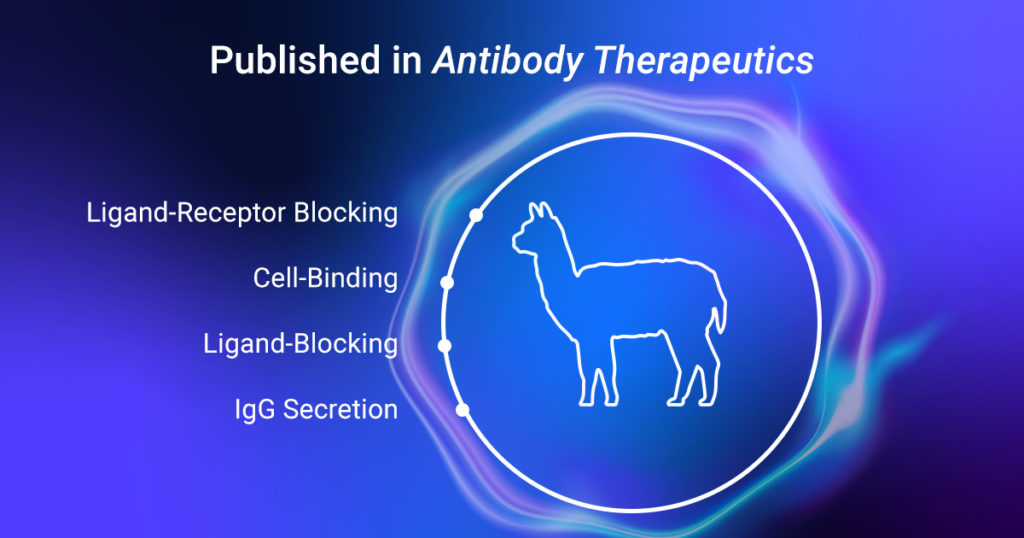Researchers have used Bruker Cellular Analysis’ Optofluidic technology to establish the fastest high-resolution workflow for the discovery and engineering of VHH antibodies yet. Scientists developed a novel application leveraging Bruker’s optofluidic Beacon® platform to detect IgG2/3 antibodies from activated memory B cells derived from alpaca peripheral blood samples. B cells secreting PSMA-specific antibodies were recovered for standard characterization, optimization, and humanization.
Bruker’s optofluidic platform enabled scientists to develop a novel application of in vivo VHH antibody discovery in a new species that paves the way for other species and repertoires to be screened.
The approach, set out in a case study published in Antibody Therapeutics, was used to discover and validate a panel of 13 candidates, directly from natural camelid immune repertoires.
Challenges and Opportunities of VHH Discovery
Recent years have seen huge increase in the use of biologic medicines, which have transformed outcomes in high-need areas including oncology and autoimmune diseases. As our understanding of the underlying mechanisms of disease increases, so does the industry’s appetite to continue on this trajectory of success.
One area with promising potential is that of single domain antibodies (sdAbs), such as VHH. They are small and soluble and with high thermostability, making them relatively easy to work with, and their high penetration rate and low immunogenicity means they can access antigens the larger monoclonal antibodies (mAbs) cannot. As such, they are currently being investigated as imaging reagents, for platelet aggregation, and a variety of conditions including respiratory syncytial virus (RSV) and rheumatoid arthritis (RA).
At the other end of the pipeline, however, sdAbs discovery is not without its challenges. In vitro approaches involve the construction of recombinant libraries of VHH sequences, cloning, and iterative rounds of panning against the target antigen. It introduces the risk for off-target reactivity, using antigen formats other than recombinant proteins is problematic, and success is heavily dependent on the quality of the library and selection reagents.
In vivo methodologies have the potential to overcome these obstacles, but they have important barriers of their own. Not only do transgenic mice that express heavy-chain antibodies (HCaB), the VHH binding domain, take time to generate, some models have reduced antibody affinity and weakened immune response. Instead, researchers are increasingly using species that naturally express HCAbs, such as alpacas. This allows for large-volume bleeds, and, importantly, may increase the chances of identifying antigen-specific candidates with higher affinity, lower off-target reactivity and more desirable biophysical properties.
With this approach now firmly established, VHH antibody discovery is ready to evolve.
A New Paradigm
Bruker Cellular Analysis’ Optofluidic workflow, which can screen up to 60,000 single B cells in five days, delivering up front functional information and increasing the quantity of quality hits, has already accelerated the discovery of candidates in mouse and human samples. Now, this proof of concept case study shows that VHH antibody discovery has just as much to gain.
Researchers immunized an alpaca with prostate specific membrane antigen (PSMA), before harvesting peripheral blood mononuclear cells (PBMCs), and isolating the B cells. These were cultured to induce IgG secretion, before being loaded on to an OptoSelect®chip, each of which contains thousands of individual NanoPen® chambers that open out onto a common channel.
The workflow uses pioneering optoelectrical positioning light technology to selectively escort each individual B cell to a NanoPen chamber. Because these pens are 100,000 times smaller in volume than a microwell it replaces, thousands of individual live cells can be assayed within minutes or hours.
IgG-coated capture beads and fluorophore-labelled Ig2/3 detection regents were then introduced to the chip, and activity imaged for 45 minutes. Next, the assay was flushed from the system, and capture beads and fluorophore-labelled recombinant PSMA detection agents were imported, again followed by a 45-minute imaging period. In total, 103,225 single cells from the PSMA-immunized alpaca were screened.
Assays performed on the cells included one to identify antibodies capable of blocking the receptor–ligand interaction that leads to an intracellular signalling cascade, and cell surface binding assays, in which secreted antibodies binding to target cells in the chip’s channel are detected using a fluorescently labelled secondary reagent. Assays, said the authors, can be performed sequentially over the course of just one working day, “providing an unparalleled level of detail regarding antibody function for more than 10,000 single B cells per chip.”
After the results were analysed, B cells of interest were individually exported, and the mRNA encoding the IgG sequenced.
Results and Implications
Of 13 recombinantly expressed VHHs, all but one bound with nanomolar affinity, and five were successfully humanised. In addition, repertoire sequencing uncovered additional variants within the clonal lineages of the validated hits.
This case study report demonstrates that the power of the Optofluidic workflow can be harnessed by those working in the sdAb field, for the ultimate good of pipelines and patients the world over.
Because the adoption of high-resolution screening assays during early antibody discovery workflow “allows rapid identification of valuable hits, and can accelerate therapeutic antibody discovery,” wrote the authors.
Reference
- Shapiro, B., Boucher, J., et al. Alpaca single B cell interrogation and heavy-chain-only antibody discovery on an optofluidic platform, Antibody Therapeutics. 2023 Jul; 6(3): 211–223. https://doi.org/10.1093/abt/tbad018

